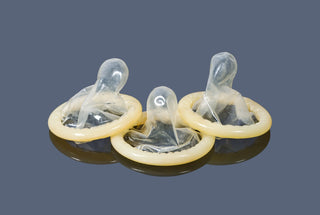If you've ever had to clean up after a busy night, you're probably wondering: can you flush condoms down the toilet? The answer is yes and no! There's a catch if you don't act responsibly. While most toilets can handle flushing a condom, it's not the best way to dispose of them.
Here's what you need to know about flushing condoms down the toilet and the best latex condoms for sustainable use.
Table of Contents:
- Is it unsanitary to throw rubbers in the toilet?
- Why you should think green when flushing condoms down the toilet
- Are condoms biodegradable?
- What are condoms made of, and how long do they take to decompose
- The best latex condoms for safe sex
- How to save the planet one condom at a time
Is it unsanitary to throw rubbers in the toilet?
Throwing condoms down the toilet can quickly become an unsanitary and hazardous problem for your household plumbing. While it can be tempting to flush them down the drain, condoms can present a challenge for wastewater treatment plants.
They can congeal in pipes, leading to even more significant issues with blocking sewers or sewage systems for everyone in your house and even your street.
Therefore, the answer to 'can you flush condoms' is quite clearly a resounding 'no' – no matter how convenient it may seem.
How to dispose of a condom
The safe disposal of condoms is either in the rubbish bin or, if you want to hide the evidence, in a plastic bag and then in a council waste bin.
Keep toilet pipes safe by tossing out all items that are not biodegradable waste.
Why you should think green when flushing condoms down the toilet
When disposing of used condoms, we recommend discarding them in the waste bin. Keeping them out of sewers or water waste systems can be challenging since items can wash through drains easily and negatively affect our environment.
So in answer to - Can you flush rubbers down the toilet? No, they can pollute natural waterways and contribute to severe clogs in both local and council sewer systems. Consider going green when possible, use an eco-friendly lubricant and opt for biodegradable condoms when available.
Are condoms biodegradable?
Since the invention of condoms, they have been made out of latex, a natural substance and biodegradable. However, non-latex condoms are not biodegradable, but like most things in life, there's no honest cut-and-dried answer.
The majority of condoms are composed of latex, which is created entirely of natural rubber tree sap and is biodegradable. Condoms made of latex and lambskin can be degraded or biodegraded. However, if the condoms are covered with a spermicide or personal lubricant, the procedure becomes a little more challenging.
Spermicide compounds are generally chemicals that may be petroleum-based, and these hamper condom decomposition. Sadly this can mean that when a condom is used and then disposed of, it will sit in the landfill for years to come. But are there other options? Are there biodegradable condom materials? Let's explore.
What are condoms made of, and how long do they take to decompose?
Condoms are thin, elastic devices made from either latex or polyurethane. They help prevent the transmission of infections and unplanned pregnancies. But once used and disposed of, how long does it take for a condom to decompose?
The answer depends on what type of condom is being discussed. Latex condoms, typically thin sheaths rolled up, can take up to five centuries (500 years!) to decompose fully.
Polyurethane condoms, often favoured by those with latex allergies, take more than double that - roughly one thousand two hundred years (1,200). That's a long time.
Are lambskin condoms biodegradable?
The natural lambskin condom, produced from lamb intestines, is the only truly biodegradable condom. These condoms will protect against pregnancy, but they are less successful in stopping the transmission of STIs. This is because viruses may pass through their naturally permeable membrane.
Because non-latex condoms take so long to decay naturally in the environment, individuals must use safe disposal options when getting rid of used condoms. This will ensure environmental harm after use is kept to a minimum.
The environmental impact of condoms
Condoms are a widespread and essential tool in the world of safe sex. But most people do not realise they can also have an environmental impact. Even though condoms are biodegradable, they can damage marine life if flushed down the toilet.
The production process also has an ecological cost. However, steps have been taken to make it as sustainable as possible, with latex extraction from trees being done with minimal collateral damage.
For instance, trees used for extracting latex retain their interlocking root systems for better stability and to protect the environment from erosion. Furthermore, waste from latex production is recycled and used in other products like rubber gloves, tires, and even shoes.
Minimising environmental footprint
To further minimise its environmental footprint, it is essential to remember to properly dispose of condoms instead of flushing them down the toilet. While landfill is not ideal, it's the best option until the clever people at the University of Texas commercially produce their plastic-eating enzyme.
The likelihood is that in less than five years, the enzyme will be widely available to reduce plastic down to a reusable chemical, therefore lessening the environmental impact of condoms.
Ways to reduce the environmental impact of using condoms
When trying to reduce the environmental impact when using condoms, one crucial factor to consider is that most condoms used today are made from natural latex. Latex can be more environmentally friendly than its synthetic counterparts, such as polyurethane because it is biodegradable and quickly absorbs carbon dioxide from the atmosphere.
Additionally, ensuring you use the correct size of condom for your anatomy is the way to ensure that your condom does not break during use, reducing waste.
Finally, reducing waste is possible by selecting packaging that does not include single-use plastics or resealable packaging and opting for companies that practice ethical line manufacturing processes.
By following these steps, one can significantly reduce their ecological footprint with every act of safe sex.
The best latex condoms for safe sex
If you want to do your best for the planet while doing what's best for you and your partner, here are our top latex condom suggestions…
Durex Thin Feel Condoms
Durex has been offering high-quality, reasonably priced condoms and lubricants for over a century. Durex is the most recognisable brand name in the condom and sexual health industries.
The Durex brand name first appeared on store shelves in 1929, a decade after the parent company's founding in 1915. The phrases “durability, reliability, and quality” that make up the name Durex are present throughout the Durex collection of condoms and lubricants.
EXS Air Thin Condoms
EXS is one of the best European condom companies that is gaining popularity in the UK. The message from EXS is relatively straightforward: they want everyone to have the freedom to express themselves in the bedroom. EXS say our ability to have safe sex without spending a fortune is their priority.
EXS has created a wide variety of condoms at great prices. For individuals who choose to live a vegan lifestyle, the EXS line now offers vegan condoms.
Glyde Ultra Condoms
When it comes to engaging in green, safe sex, Glyde takes pleasure in being the vegan condom brand, guaranteeing that you do not have to compromise your morals. Glyde condoms are not merely labelled as vegan; since 2006, they have been officially recognised by the Vegan Society.
As a result, you can be sure that what you buy is genuinely vegan and not just marketing speak. Since Glyde's beginnings in Sydney, they have expanded quickly owing to their moral principles and superior condoms exceeding consumers' expectations.
Purchasing some Glyde condoms is the only option if you want a condom that is highly ethical, of the highest quality, and has assisted many individuals worldwide.
Lelo Hex Respect Condoms
Lelo Hex, dubbed “the condom of the future,” is a cutting-edge condom produced by the well-known sex toy company Lelo. The distinctive, patented design of the Lelo condoms, which is the reason for the product's name and consists of independent and linked hexagons, sets them apart from all others.
Why is the pattern hexagonal? It's easy. Lelo developed this construction to address and resolve some of the most prevalent condom problems, such as restriction and breaking during sex. This structure, akin to a honeycomb, provides resistance, enabling the firm to keep its condoms' ultra-thin profiles.
This way, Lelo Hex condoms are non-tearing and provide a more fantastic range of movement and more powerful feelings than any other condom.
How to save the planet one condom at a time
- Choose a sustainable brand. Glyde is a firm that manufactures fair trade, vegan, and ethical condoms. Additionally, Glyde uses recycled materials, soy, and vegetable inks to create its consumer packaging.
- Condoms should be disposed of responsibly. Although condoms create trash, we believe this type of waste is better for society than having an unplanned child or an STI. But remember that latex condoms are composed of rubber, a natural substance.
- Don't let your condoms expire - have sex regularly; that way, you won't waste your condoms by allowing them to dry up in the drawer.
So our conclusion to the question - "can condoms be flushed?" is NO - DO NOT throw condoms down the toilet. Use and dispose of them responsibly and remember, the plant doesn't need unwanted children, and you don't need a nasty dose. Stay safe, and buy your condoms with care.





